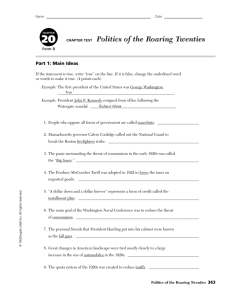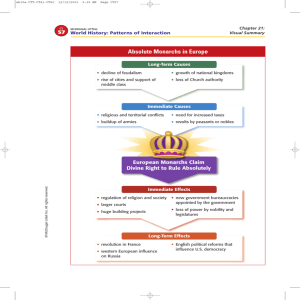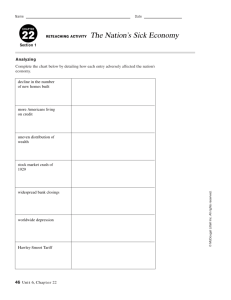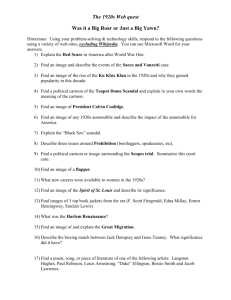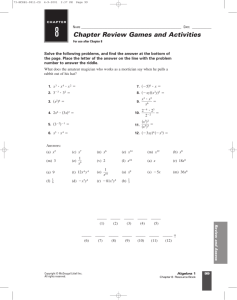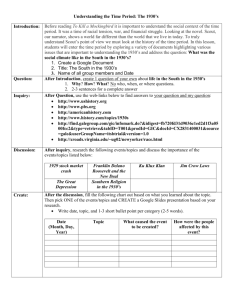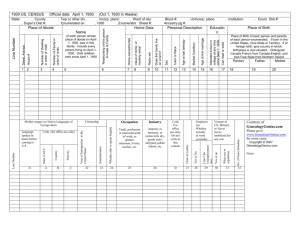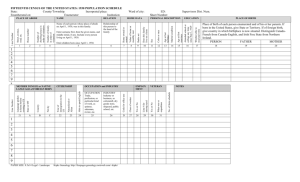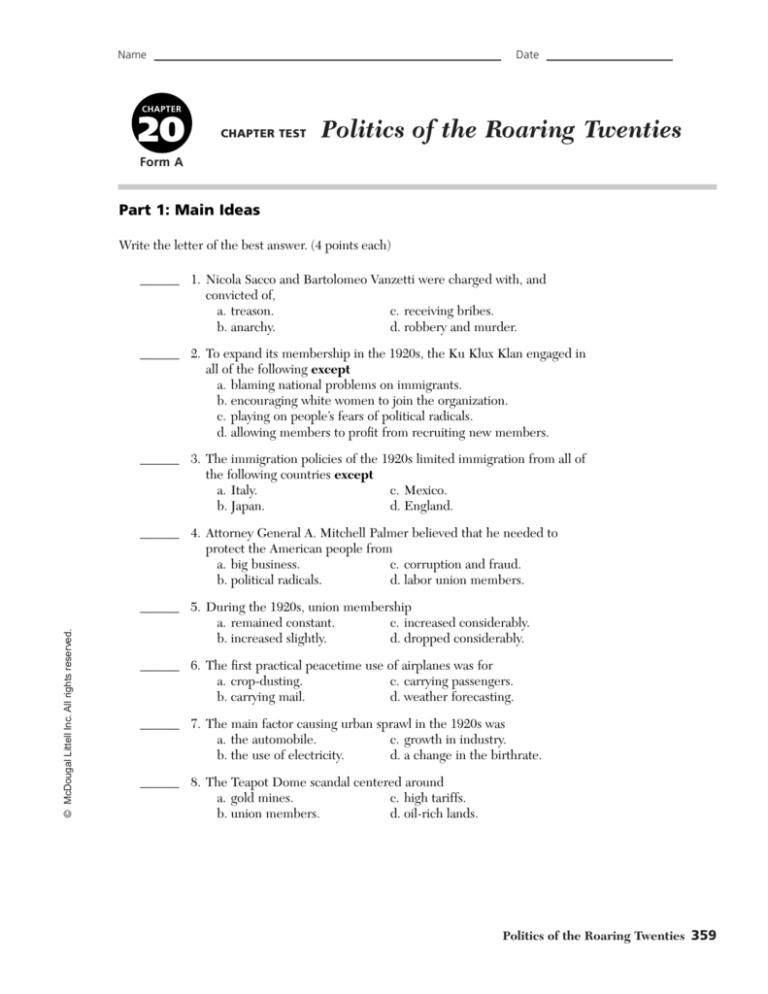
Name
Date
CHAPTER
20
CHAPTER TEST
Politics of the Roaring Twenties
Form A
Part 1: Main Ideas
Write the letter of the best answer. (4 points each)
______ 1. Nicola Sacco and Bartolomeo Vanzetti were charged with, and
convicted of,
a. treason.
c. receiving bribes.
b. anarchy.
d. robbery and murder.
______ 2. To expand its membership in the 1920s, the Ku Klux Klan engaged in
all of the following except
a. blaming national problems on immigrants.
b. encouraging white women to join the organization.
c. playing on people’s fears of political radicals.
d. allowing members to profit from recruiting new members.
______ 3. The immigration policies of the 1920s limited immigration from all of
the following countries except
a. Italy.
c. Mexico.
b. Japan.
d. England.
© McDougal Littell Inc. All rights reserved.
______ 4. Attorney General A. Mitchell Palmer believed that he needed to
protect the American people from
a. big business.
c. corruption and fraud.
b. political radicals.
d. labor union members.
______ 5. During the 1920s, union membership
a. remained constant.
c. increased considerably.
b. increased slightly.
d. dropped considerably.
______ 6. The first practical peacetime use of airplanes was for
a. crop-dusting.
c. carrying passengers.
b. carrying mail.
d. weather forecasting.
______ 7. The main factor causing urban sprawl in the 1920s was
a. the automobile.
c. growth in industry.
b. the use of electricity.
d. a change in the birthrate.
______ 8. The Teapot Dome scandal centered around
a. gold mines.
c. high tariffs.
b. union members.
d. oil-rich lands.
Politics of the Roaring Twenties 359
Name
Test Form A continued
______ 9. The Fordney-McCumber Tariff was meant to
a. help Britain and France pay off their war debts.
b. raise taxes on goods entering the United States.
c. help Germany pay off its war debts.
d. raise taxes on goods leaving the United States.
______ 10. To protect their own interests, employers often accused striking
workers of being
a. spies.
c. bigots.
b. Communists.
d. nativists.
Part 2: Map Skills
Use the map to complete this section. Write the letter of the best answer. (4 points each)
Civil Air Routes, 1918 – 1930
Victoria
CANADA
Seattle
Portland
Great Falls
Montreal
Boise
Boston
Minneapolis
New York
Detroit
Salt Lake
City
San Francisco
Chicago
Cheyenne
Denver
Philadelphia
Pittsburgh
Washington
Omaha
Kansas City
St. Louis
Las Vegas
Nashville
Albuquerque
Airport
Oklahoma
City
N
Tucson
El Paso
0
Air Routes
Fort Worth
Dallas
Jacksonville
New
Orleans
500 Miles
1000 Kilometers
1930: Flights begin to Mexico
and Central America
Brownsville
1930: Flights begin to Cuba
and South America
In 1918
By 1921
Pilottown
MEXICO
0
Atlanta
Miami
By 1930
______ 11. The first civil air route connected New York with
a. Chicago.
c. San Francisco.
b. Montreal.
d. Washington.
______ 12. According to the map, the first international air route was available
a. in 1918.
c. by 1930.
b. by 1921.
d. after 1930.
______ 13. A plane traveling from Chicago’s airport to the airport in Minneapolis
would have to travel
a. northeast.
c. northwest.
b. southeast.
d. southwest.
360 Unit 6, Chapter 20
© McDougal Littell Inc. All rights reserved.
Los Angeles
Name
Test Form A continued
______ 14. New Orleans was first served by an air route
a. in 1918.
c. by 1930.
b. by 1921.
d. after 1930.
______ 15. According to the map, in 1930 it was possible to fly a scheduled route
from the United States to
a. Cuba.
c. France.
b. China.
d. Hawaii.
Part 3: Interpreting Political Cartoons
© McDougal Littell Inc. All rights reserved.
Use the cartoon to complete questions 16–20 on page 362. Write the letter of the best
answer. (4 points each)
—from the Literary Digest, March 20, 1920
Politics of the Roaring Twenties 361
Name
Test Form A continued
______ 16. Who are the men in the cartoon?
a. government officials
c. foreigners
b. radicals
d. unskilled laborers
______ 17. In this cartoon, what bigger idea does the “light” represent?
a. radicalism of foreigners
c. the truth about America
b. anarchy
d. Soviet communist ideals
______ 18. According to the cartoon, which of the following is an example of the
kind of ideas that shut out the light?
a. truth
c. the labor movement
b. the opinions of the public d. Soviet doctrines
______ 19. What is the main difference between the two men in the cartoon?
a. One is a leader.
c. One is a Communist.
b. One is a skilled laborer.
d. One is a radical.
______ 20. Which statement best expresses the main idea of this cartoon?
a. Tasks are accomplished through hard work and the leadership of
strong individuals.
b. Radicals use foreign and communist propaganda to block the good,
honest ideals of America.
c. The U.S. government should consider the new ideas of foreigners
instead of relying on American public opinion.
d. Radicals illustrate the best features of Americans: hard work,
leadership, and a drive to succeed.
Part 4: Extended Response
21. Warren G. Harding’s presidency was plagued by scandal, and it was later
regarded as unsuccessful. Explain why President Harding was popular with
the American public despite these facts. Think About:
• American attitudes and feelings after World War I
• Harding’s appearance, personality, and promises
• the yearning for the simpler days before the Progressive Era and World War I
22. What technological invention or advancement of the 1920s had the biggest
impact on the life of the average American? Explain your opinion.
Think About:
• advances in the fields of business, transportation, power, and machinery
• the basic needs of Americans
• the conveniences offered by new technology
362 Unit 6, Chapter 20
© McDougal Littell Inc. All rights reserved.
Answer each of the following questions in a paragraph on the back of this paper or on a
separate sheet. (10 points each)

